RESEARCH PROGRAMMES
Organization of multidisciplinary research of applied nature is conducted through
State plan, All India Coordinated Research Project on Agro forestry, National Network
of Research and Development Programme on Karanj and Bio-Drainage Project.
All India Coordinated Research Project on Agro forestry funded by ICAR, New Delhi
(Continuing)
- Evaluation of MPTs
- Management of agroforestry systems / practices
- On Farm trials on watershed basis
National Network of Research and Development Program on Karanj funded by NOVOD (Completed)
Survey and collection of superior planting material
- Establishment of progeny trial
- Conduct of Karanj based Agri silviculture trial
- Standardization of propagation techniques
Bamboo mission project (Completed)
- Increase productivity of bamboo in non-forest area to reduce pressure on the forest
- Increase the productivity of poor / degraded / wastelands through adoption of bamboo
based Agroforestry system.
- Develop suitable bamboo based Agroforestry model
for raising the current income of farming communities.
- Demonstration of Agri-silviculture/Silvipastoral
model at farmer’s field Impact assessment of transferable technologies.
Bio drainage project (Continuing)
- To test bio-drainage system under farm setting and study the interactions between
trees and coexisting crops of the Tawa Canal Command and to develop guidelines for
planning and designing bio-drainage.
MPTS (Provenance Trial of Babul and Shisham)
- At the age of 5½ year, Firojpur (Haryana) Babul provenance (T27) recorded significantly
higher plant height (476 cm) and collar diameter (74 mm Provenance T27 also recorded
highest CAI and MAI. provenance (T19) recorded significantly lower plant and collar
diameter as well
- At the age of 5½ years, provenance of Shisham received from
NRC Jhansi (T7) recorded higher plant height (693 cm) and collar diameter (70 mm)
and dbh (58 mm).
AGROFORESTRY MANAGEMENT
Agrisilviculture system (D.sissoo + Paddy-Mustard/Gram/Wheat rotation)
- Under 18 years old agrisilviculture system (D.sissoo + Paddy-Mustard/Gram/Wheat
rotation) where 4 pruning treatments (viz; no pruning, 25%, 50% and 75% pruning)
and one open were carried out in main plot and three crop rotation i.e. [T1- Early
paddy (Danteshwari) + Mustard], [T2- Medium paddy (MTU-1010) + Gram], [T3- Late
paddy (Kranti) + Wheat] in sub plot; replicated five times. Different pruning treatments
showed significant influence on grain yield of paddy varieties. Significant maximum
grain yield of paddy was recorded under open condition (1600 kg ha-1) at par with
75 % pruning (1464 kg ha-1) and 50 % pruning (1333 kg ha-1). No pruning recorded
significantly lowest grain yield (862 kg ha-1) at par with 25 % pruning (875 kg
ha-1).
- The percent reduction in grain yield under no pruning, 25%, 50% and 75% pruning
as compared to open condition was 46%, 45%, 16.7% and 8.5%, respectively.
- Different duration of paddy varieties showed significant effect on grain yield.
Medium duration paddy variety i.e. MTU-1010 recorded higher grain yield (1397 kg
ha-1) at par with late maturing kranti variety (1393 kg ha-1) and were significantly
superior to early maturing Danteshwari variety (890 kg ha-1).
- The percent increase in yield under MTU-1010 over Danteshwari was 36.0 percent.
- During rabi season crops viz., mustard, gram and wheat were sown after paddy. Wheat
equivalent yield was workout. Significantly higher wheat equivalent yield (8832
kg ha-1) was recorded under open condition and was significantly superior to all
the pruning treatments. No pruning recorded significantly lowest yield (5063 kg
ha-1).
- Significantly higher wheat equivalent yield (15766 kg ha-1) was recorded under late
paddy + wheat followed by early paddy+ mustard (2787 kg ha-1) and medium paddy+
Gram (1176 kg ha-1) which were at par.
- Significantly maximum net monetary return was recorded under D. sissoo + medium
paddy (MTU-1010) + Gram (Rs. 63688 ha-1) crop rotation closely followed by D. sissoo
+ early paddy (Danteshwari) + Mustard (Rs. 63138 ha-1).
Water Foot-print
Water footprint of different paddy variety
- The study revealed that the total water footprint of MTU 1010 (3.474 m3 kg-1) and
Kranti (4.455 m3 kg-1) were at par but significantly lower than Danteshwari (5.957
m3 kg-1). It means MTU 1010 used only 3474 liters of water where as Kranti used
4455 liters and Danteshwari used 5957 liters of water to produce 1 kg paddy equivalent
yield.
Effect of pruning intensities on total water footprint of agroforestry
- During the course of investigation total water footprint (green+blue+grey) of 25%
pruning (1.754 m3 kg-1) was significantly lower than the other pruning treatments.
WF of 0% pruning (3.156 m3 kg-1) 50% pruning (2.497 m3 kg-1) and 75% pruning (2.691
m3 kg-1) were at par. It means 25% pruning used only 1754 liters of water to produce
1 kg of paddy equivalent yield from D.sissoo-paddy agroforestry system whereas other
pruning treatments used much more water for 1 kg PEY.
Water Footprint in different cropping system
- Water footprint (WF) of five cropping system viz. agriculture, unmanaged silviculture,
managed silviculture, unmanaged agroforestry, managed agroforestry were determined.
Results revealed that WF of managed silviculture (1.612 m3 kg-1) was significantly
smaller among all five cropping systems. It used only 1612 liters of water to produce
1 kg paddy equivalent yield (PEY). WF of managed agroforestry (2.105 m3 kg-1) was
lowest among remaining four cropping systems. It used only 2105 liters of water
to produce 1 kg PEY. WF of unmanaged silviculture (2.405 m3 kg-1) was lowest among
remaining three cropping systems. It used only 2405 liters of water to produce 1
kg PEY. WF of agriculture (2.812 m3 kg-1) was lowest among remaining two cropping
systems. It used 2812 liters of water to produce 1 kg PEY. Significantly highest
WF was recorded for unmanaged agroforestry (3.123 m3 kg-1). It used 3123 liters
of water to produce 1 kg PEY.
Hortipastoral system (Guava + fodder oat)
- In 19 years old hortipastoral system (Guava + fodder oat) four pruning treatment
i.e. levels of deheading viz; no deheading, deheading at 1.0m, 1.5m, 2m, height
and one open (crop without tree) in main plot and two oat fodder varieties (viz.
J0-2, J0-3-93) and two time of cutting (1 cut at 75 DAS and 2 cuts at 45and 75 DAS)
in sub plot, replicated three times.
- Significantly higher green fodder yield was recorded under open condition (27169
kg ha-1) as compared to other deheading treatments which was at par, however, deheading
at 1.0 m height recorded higher green fodder yield (16396 kg ha-1) and no deheading
recorded lowest yield (13088 kg ha-1).
- In both the varieties, single cutting (75 DAS i.e. 50% flowering) recorded singnificantly
higher green fodder yield as compared to two cutting (45 and 75 DAS). Among varieties
Jo-2 recorded higher green fodder yield as compared to Jo-3-93, through the difference
was not significant.
- Agrihorticulture system (Guava + Oat) was more profitable (54,780 ha-1) than growing
of fruit crop alone i.e., orchards (Rs. 35,160 ha-1). Under managed Agroforestry
system i.e. growing of oat as fodder with Guava in different levels of deheading,
oat+Guava in 2.0 m deheading of main shoot was more profitable (Rs. 57,573 ha�1)
and at par with other pruning treatment but superior to tree alone (Rs 35,160 ha�1)
and crop alone (Rs 43,338 ha�1)
- Variety Jo-2 with single cutting (75 DAS) recorded
significantly higher net profit (Rs. 57,125 ha-1) at par with Jo-3-93 in single
cutting but significantly superior to two cuttings under both varieties.
Agrisilviculture system (D. sissoo + wheat)
- Under 18 years old agrisilvicultural system (D. sissoo + wheat) in which, four pruning
treatment viz; no pruning, 25%, 50%, and 75% in D. sissoo + one open in main plot
and three levels of fertilizer dose viz., [T1- recommended dose i.e. 120:60:40::
N:P:K kg ha-1, T2 – 25% more nitrogen than recommended dose and T3 - 50% more nitrogen
than recommended dose] in subplot, replicated 4 times.
- Open condition recorded significantly higher grain yield (2924 kg ha-1) than other
pruning treatments. No pruning recorded significantly lowest grain yield (1460 kg
ha-1). 50% more nitrogen than recommended dose of fertilizer recorded significantly
higher grain yield (2246 kg ha-1) than 25% more nitrogen and recommended dose (2027
kg ha-1).
- Managed agroforestry gave higher monetary return (Rs. 63663 ha-1) as compared to
unmanaged agroforestry system i.e. no pruning (Rs. 59878 ha-1). Under managed agroforestry
system, D. sissoo + wheat in 25% pruning recorded higher monetary return (Rs. 76559
ha-1) as compared to crop alone (Rs. 30787 ha-1) and tree alone (Rs. 43743 ha-1)
ON FARM TRIAL
Eucalyptus based Agrisilviculture system (Eucalyptus + Paddy + Wheat, Paddy + mustard
and Arhar)
- Agrisilviculture system (Eucalyptus + crop) gave higher monetary return than growing
of crop alone and tree alone.
- Among different cropping system, growing of Arhar with Eucalyptus gave higher net
profit (Rs. 96,260 ha-1 yr-1) as compared to Eucalyptus + Paddy+ mustard (Rs. 74,980
ha-1 yr-1) Eucalyptus + Paddy+ wheat (Rs. 74,385 ha-1 yr-1). Eucalyptus alone (Rs.
42,060 ha-1 yr-1) Arhar alone (Rs. 60,500 ha-1 yr-1), paddy + mustard alone (Rs.
5,150 ha-1 yr-1) and paddy + wheat alone (Rs. 52,335 ha-1 yr-1),
- Above ground CO2 sequestration potential (CSP) was found significantly higher under
Eucalyptus + pigeopea agrisilviculture (34.22 t ha-1 yr-1), as compared to Eucalyptus
paddy wheat agrisilviculture system (30.55 t ha-1 yr-1).
Aonla based Agrihorticulture system (Aonla + wheat)
- Agrihorticulture system (Aonla + wheat) was more profitable (Rs. 47,600 ha-1) as
compared to wheat alone (Rs. 39,400 ha-1). The B:C ratio of Agrihorticulture system
was more (2.64) as compared to growing of crop alone (2.62).
Mango based Agrihorticulture system (Mango+Wheat)
- Mango based agrihorticulture system (Mango + wheat) was more profitable (Rs. 41,300
ha-1) as compared to growing of crop alone (Rs. 31,000 ha-1). The B:C ratio of Agrihorticulture
system was more (2.84) as compared to growing of crop alone (2.21).
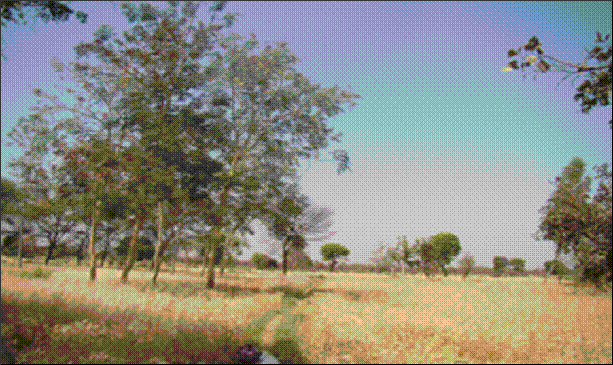 |
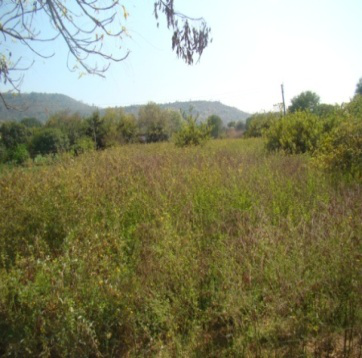 |
|
MPTS + Crops |
Guava + Rabi Crops |
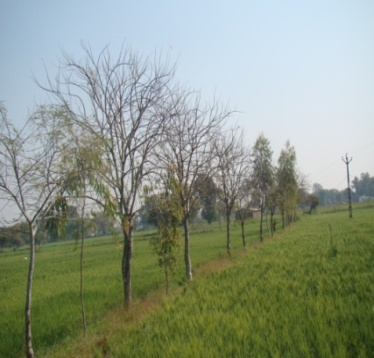 |
 |
|
Aonla+ Eucalyptus+ Crops |
Mango+Sissoo+crop |
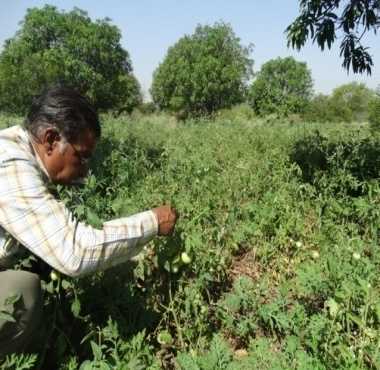 |
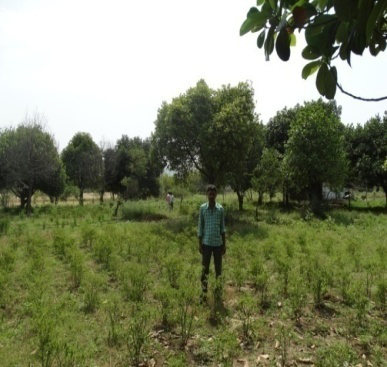 |
|
Mango + Tomato |
Jack fruit + Chilli |
 |
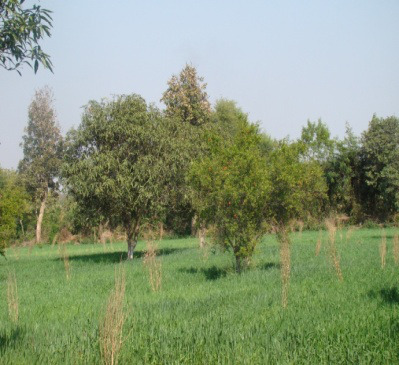 |
|
Eucalyptus + Arhar |
Mango + Anar + Citrus+ wheat |
AGROFORESTRY MANAGEMENT
Hortipastoral Practice (Guava + Fodder oat)
- Significantly higher net profit (Rs. 59464 ha-1) was recorded under 2.0 m deheading
of guava at par with deheading at 1.5 m height (Rs. 58032 ha-1) and 1.0 m height
(Rs. 55477 ha-1). Significantly lowest monetary return was recorded under open condition
(Rs. 43298 ha-1).
- Variety J0-2 recorded significantly higher monetary return (Rs. 58145 ha-1) closely
followed by variety JO-91 (Rs. 54433 ha-1) and was superior to variety JO-1 (Rs.
53189 ha-1) and Kent (Rs. 51015 ha-1).
Agrisilviculture (D.sissoo + paddy-wheat)
- Under manage agroforestry system, paddy-wheat + D. sissoo in 50% pruning gave significantly
higher monetary return (Rs. 84428 ha-1) than crop alone (Rs. 60281 ha-1), tree alone
(Rs. 39490 ha-1).
- The LAI and CGR were significantly higher under open conditions of wheat alone and
it was at par with the crop under 75% pruned D. sisoo.
Silvimedicinal system (D. sissoo + turmeric)
- Significantly higher monetary higher monetary return was obtained when turmeric
grown with D.sissoo in 25% pruning (Rs. 160479 ha-1) and was significantly superior
to 50% pruning, no pruning (Rs 115040 ha-1) and 75 % pruning (Rs.102591 ha-1. Crop
grown under open conditions recorded significantly lowest monetary return (Rs. 55312
ha-1).
- Early sowing (20 June) gave, higher monetary return (Rs. 144903 ha-1) at par with
sowing on 27th June recorded (Rs. 124971 ha-1). Late sowing recorded significantly
lowest monetary return (Rs 70521 ha-1).
.png) |
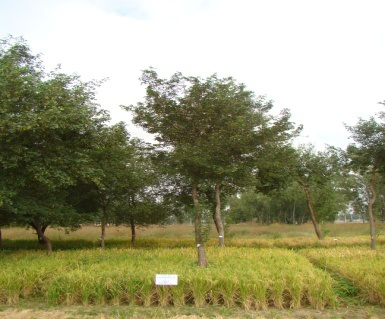 |
|
Study of pruning intensities in Psidium guajava (Gauva) |
Study of pruning intensities in D. sissoo on wood biomass |
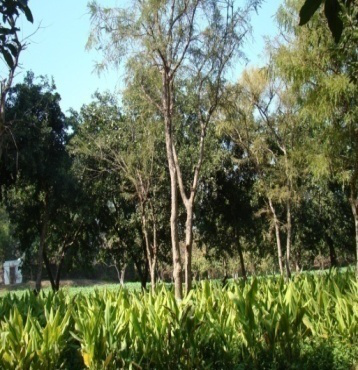 |
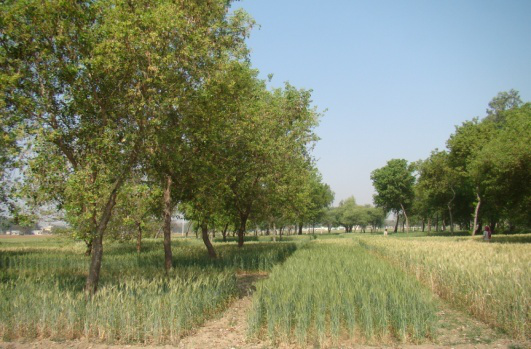 |
|
Bel+ Turmeric |
D. sissoo based Agrisilviculture system |
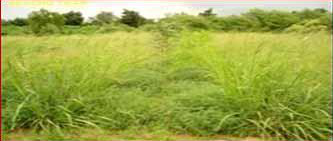 |
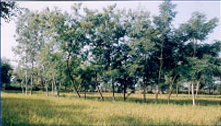 |
|
Babul + paddy |
Bamboo + grasses |
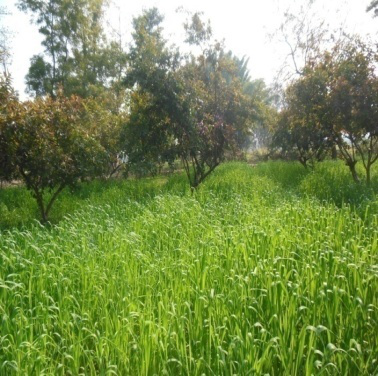 |
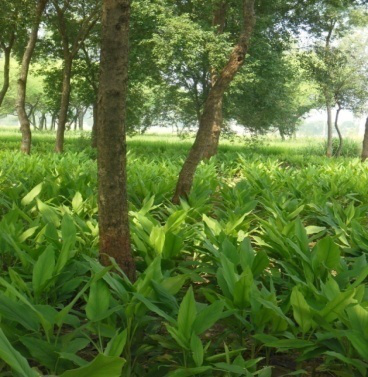 |
|
Gauva + Oat |
D. sissoo + Turmeric |
ON FARM TRIAL
Eucalyptus based Agrisilviculture system (Eucalyptus+ Wheat- gram and vegetables)
- Under on farm trial different crops (wheat, gram and vegetables) grown with Eucalyptus
showed that growing of vegetables gave more return Rs 24,000 ha-1 as compared to
gram (Rs 23,000 ha-1) and wheat alone (Rs 16,000 ha-1).
Eucalyptus based Agrisilviculture system (Eucalyptus + Paddy- moong- soyabean +
wheat-mustard)
- Agrisilviculture system (Eucalyptus + crop) gave higher monetary return than growing
of crop alone and tree alone. Among different crop combinations with Eucalyptus,
Eucalyptus with Arhar gave higher net profit (Rs. 86,932 ha-1 yr-1 followed by Paddy
+ Wheat (Rs. 78,232 ha-1 yr-1), Soyabean+ Wheat (Rs. 71,112 ha-1yr-1), Moong + Mustard
(Rs.65,992 ha-1yr-1), Paddy + Mustard (Rs. 65, 312 ha-1yr-1), Moong + wheat (Rs
62, 912 ha-1yr-1) and Soyabean + Mustard (Rs 58,192 ha-1yr-1).
Guava based Agrihorticulture system (Guava + turmeric)
- At the age of 3 year of plantation of Guava + turmeric based agrihorticulture gave
higher monetary return (Rs. 1,58,000 ha-1) as compared to growing of fruit crop
alone (Rs. 8,000 ha-1) and turmeric alone (Rs. 1,50,000 ha-1).
Eucalyptus based Agrisilviculture system (Eucalyptus + wheat- bamboo)
- Growing of wheat (First and Second year) and Bamboo (3rd year sowing of bamboo seeds
and 4th year rhizomes used for raising seedling) with Eucalyptus was more profitable
and gave net profit of Rs. 3,73,700 ha-1yr-1 as compared to growing of wheat (Continuous
for first 3 Years and no crop during 4th year) with Eucalyptus which gave net profit
of Rs. 1, 50,000 ha-1 yr-1).
Forestry—Agroforestry systems and practices recommendations
- Paddy variety (JR 201) can profitably be grown with Babul, Sissoo and Guava trees
under alley cropping and Agrihorticulture practice of Agroforestry than growing
sole crop of paddy or guava in rain fed conditions.
- Average performance of ten year old babul provenance trial revealed that the growing
of paddy crop with Babul (Bilaspur provenance) under alley cropping is economical.
- In Agrihorticulture practice (Guava + Paddy) ,twice hand weeding (at 30 & 45
days after sowing) is found economical as it gave 31% higher yield of paddy than
one hand weeding (i.e. at 30 days after sowing).
- In Agrihorticulture practice (Guava + Turmeric), raised bed method of planting turmeric
gave 33% and 88% higher monetary return over flat and furrow bed methods under irrigated
(dairy waste water) conditions, respectively.
- In Agrisilviculture system of agroforestry, growing of multipurpose tree species
at a spacing of 1m x 1m on farm bunds has been recommend for producing more biomass
per unit area.
- In Agrisilviculture system (Sissoo + Wheat), 75% pruning intensities has been found
most economical at the early stage of tree growth whereas 25% pruning intensities
has been found economical at later stages of tree growth (>5 years of age) for
higher biomass production per unit area.
- The partitioning of precipitation losses ,in fifteen years old Bel tree (Aegle marvelous)
, revealed that the losses through stem flow, through fall and interception losses
were 2%, 84% and 14%, respectively.
- The partitioning of precipitation losses, in 15 years old Imli (Tarmindus indica),
revealed that the stem flow, through fall and interceptions were 6%, 70% and 24%
respectively.
- The partitioning of precipitation losses, in 15 years old Bahera (Terminalia belerica),
revealed that the losses through stem flow, through fall and interceptions were
8%, 72% and 20%, respectively.
- Bruchus bilinitophagus causes 66% seed damage in Kalasiris (Albizia lebbeck) .This
insect has shown maximum fecundity up to 76%. Adult emergence was found up to 27%
on the seeds of the said tree species.
- Seed treatment in combination with soil drenching with Thiram (0.3%) or biocontrol
agent (Thichoderma veride) @ 0.2% separately or Bavistin 0.1% before sowing was
found effective in controlling root rot of babul seedlings.
- Firojpur provenance of Babul (Acacia nilotica) is recommended for plantation under
rain fed conditions in agroforestry systems.
- 31. Specific parameter i.e. corpulent base of first order branch has been identified
for selecting high green leaf fodder producing genotypes of Babul (Acacia nilotica)
at the age of 18 months.
- Juvenile-mature growth correlation i.e. between first year and tenth year measurements
in the field indicated that nine years could be cut from short rotation biomass
breeding cycle. Thus, a saving of nine years in short rotation program could affect
gain per unit time by allowing early identification of genotypes to place in accelerated
breeding facilities and by identifying genotypes for vegetative propagation of planting
stock for cloned forestry at an age when the material is still easy to root.
Bamboo mission project.
Silvopastoral system
- Different grasses showed significant effect on green fodder production during both
the cuttings. In first cutting P. purpureum recorded significantly higher yield
(373.78 tha-1) In the second cutting, the trend was more or less same and P. purpureum
recorded significantly higher yield (77.33 tha-1) and C. ciliaris recorded significantly
lowest yield (19.11 tha-1).
- Green fodder yield of stylo grass was significantly affected by different grasses
during first cutting. Significantly higher yield of stylo was recorded in D. annulatum
(57.81 tha-1) followed by C. ciliaris (51.07 tha-1) and P. maximum (45.84 tha-1).
Lowest yield of Stylo (35.67 tha-1) was recorded when grown with P. purpureum.In
second cutting different grass showed no significant effect on stylo yield.
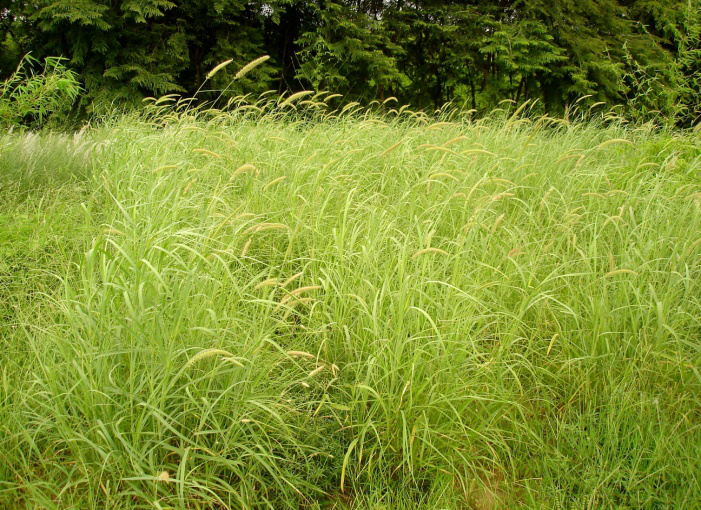 |
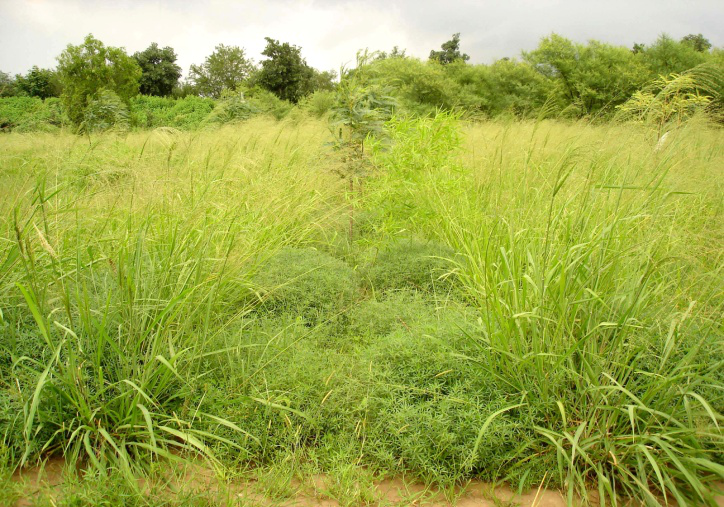 |
|
Bamboo + Stylo + Napier Grass |
- In total yield (Grass + Stylo) different grasses showed significant effect in first
cutting. Significantly higher total yield (409.45 tha-1) was recorded in P. purpureum
+ Stylo followed by P. maximum + Stylo (287.61 tha-1) and C. ciliaris + Stylo (182.67
tha-1). Significantly lowest total yield (131.59 tha-1) was recorded in D. annulatum
+ Stylo. In second cutting, different grasses showed no significant effect on total
green fodder production (grass+stylo)
Agri-silviculture practices
- 2 species of bamboo (Dendrocalamusstrictus and D. arundinacea) with Sesbaniagrandiflora
was planted within bamboo rows at a spacing of 4m with Soybean (Glycine max), Paddy
(Oryza sativa), Moong (Vignaradiata) and Til (Sesamumindicum)
- Bamboo height increased with increasing age. Different bamboo species showed no
significant effect on plant height at different growth stages i.e. 12, 15, 18 and
21months. In all the observations, D. strictus recorded higher plant height as compared
to B. arundinacea. The range of plant height during second year in D. srictus varies
from 135.95 cms to 304.43 cms, whereas B. arundinacea varies from 127.27 to 287.84
cms.
- Among different crops, Paddy recorded significantly higher yield (18.06 Q/ha) and
was significantly superior to Soybean (5.96 Q/ha), Moong (3.96 Q/ha) and Til (3.85
Q/ha) which were at par among themselves
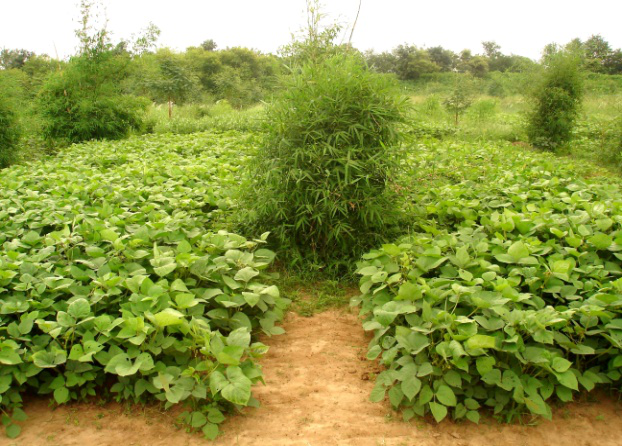 |
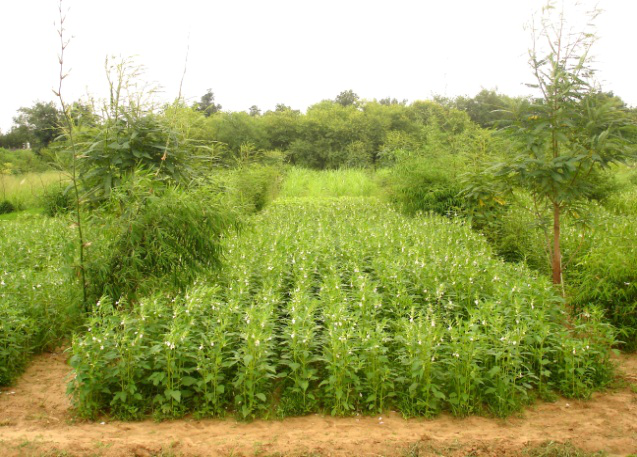 |
|
Bamboo + Agast + Moong |
Bamboo + Agast + Til |
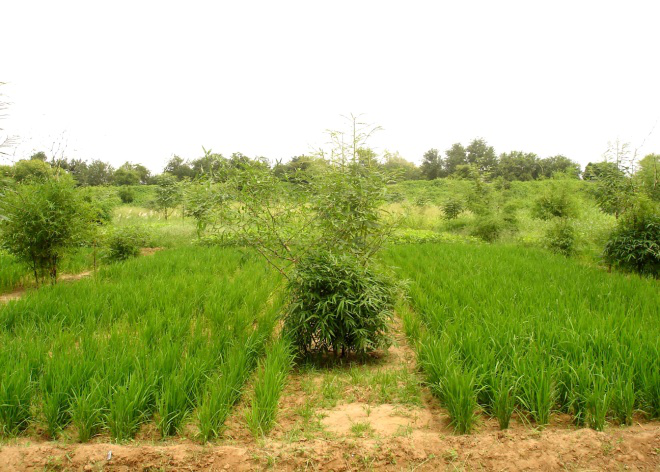 |
 |
|
Bamboo + Agast + Paddy |
Bamboo + Agast + Soybean |
National Network of Research and Development Program on Karanj funded by NOVOD
Establishment of progeny trial in field
- A trait lines of 22 progenies (seeds collected 05-06) were transplanted in the field
in RBD design with three replications at age of 45 days. At the age of 4½ year progenies,
T 10 Bargi (Jabalpur) (293 cms) recorded higher plant height followed by T 13 Nagod
road ( 286 cm) and T 3 Baharipari (Bargi) and T 5 TFRI Gour river (281 cms), whereas
T21 (KVK Seoni) recorded the lowest (173 cms). Similarly progeny T 13 (Nagod road)
Satna recorded thicker basal diameter (59.3 mm) & dbh (26.3 mm) whereas T 21
(KVK Seoni) recorded the lowest basal diameter (24.7 mm) and dbh (13.0 mm).
- A trait line of 40 progenies (seeds collected 06-07) were transplanted in the field
in RBD design with three replication at the age of 45 days. Result revealed that
among 40 progenies JNK 21 performed significantly better in plant height (278 cm)
whereas JNK 38 Raisalpur, Itarsi (Hosangabad ) recorded lowest plant height (121
cm ) at 3½ Years. JNK 15 (Khandwa road Indore) recorded higher basal diameter (52.1
mm) and dbh (26.2 mm) whereas JNK 8 recoded lowest basal diameter (16.1 mm) and
dbh (5.7 mm) .
Multilocation trial
- At the age of 4½ year T 2 PKVK PRW recorded higher plant height (246 cms), basal
diameter (45.7 mm) and dbh (19.6 mm), whereas RAK 22 recorded lowest plant height
(205 cms), basal diameter (30.9 mm) and dbh (13.9 mm).
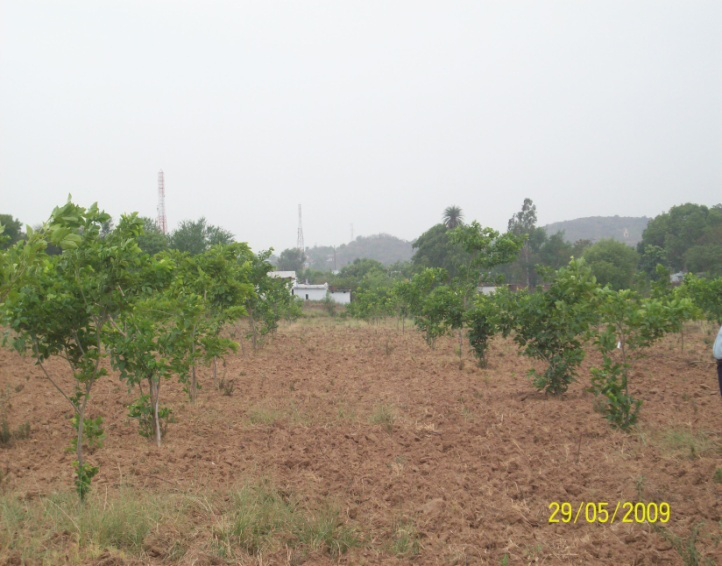 |
 |
|
Field view of National trial in the field at the age of 4½ years |
Bio Drainage Research Under Tawa Command Area
A study related to “Identification of Potential Vegetation for Bio-drainage &
fittingin evaluation of Bio-drainage in Tawa Command of Madhya Pradesh” atNimsadia-
Jasalpur villages of Hoshangabad District Agro climatic Zone IV of Tawa command
is running under the department since 2010-11 with the objectives to test bio-drainage
system under farm setting and study the interactions between trees and coexisting
crops of the Tawa Canal Command and to develop guidelines for planning and designing
bio-drainage.
Water Table Behavior
The weekly water table observations were recorded from these 46 wells. As per the
category of fields 30 observation wells spread into 87 ha of sever water logged
fields, 10 observation wells spread into 31 ha of critical water logged area and
6 observation wells belonging to 25 ha of normal fields. The mean water table below
ground were 0.35 m, 1.10 m and 2.24 m respectively for the severe water logged area,
critical water logged area and normal fields of Nimsadia, Jasalpur villages.
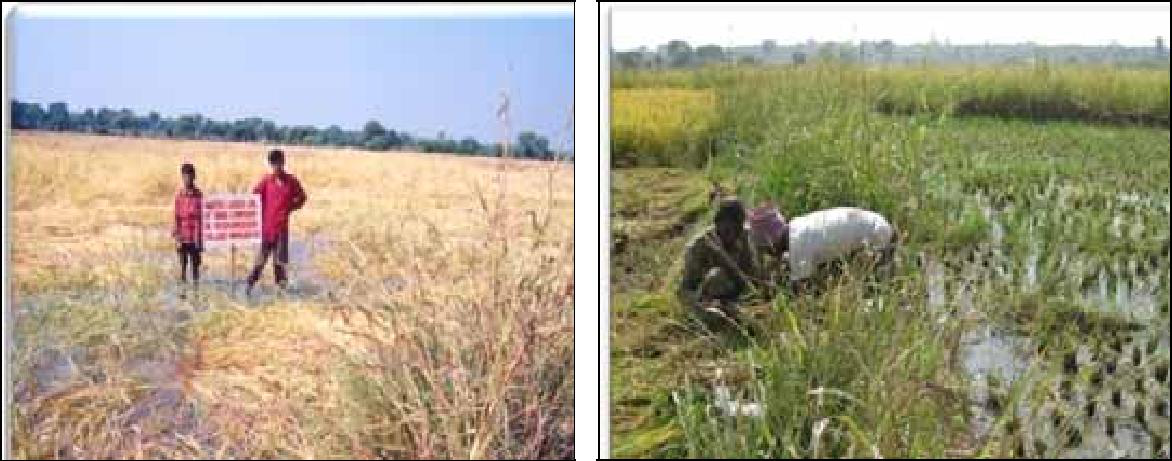 |
|
Water logged field of the farmers depicting almost same situation even after 9 years |
|
Comparison of
Water Table |
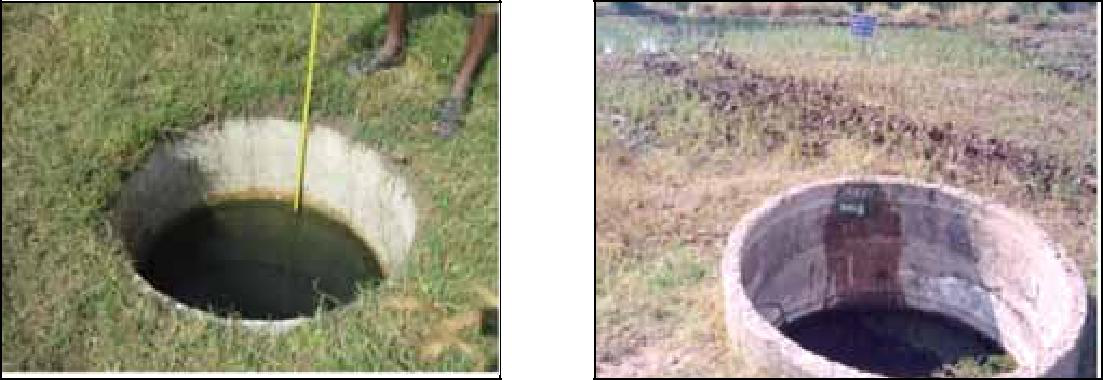 |
|
High water table in the wells of farmers depicting almost same situation in Water
table depth in after 9 years |
Six selected tree species viz; Acacia nilotica, Albiziaprocera, Dalbergiasissoo,Eucalyptus
species, LeucaenaleucocephalaandTerminaliaarjunawere startedplanting on farmer’s
field bunds since December 2011. In June 2012, main drain i.e. a nallah called JhinnaNallah
was excavated to a length of 729 m with mean depth of 1.1 meter. Nallah banks were
planted with Acacia nilotica and Leucaenaleucocephala tree species. The planting
of these selected tree species onfarmers bunds were continued in each subsequent
season of Rabi and Kharif. The water logged area was also distinguished as recharge
and discharge zones.
As observed the mean water table depth of the study area was 168 cm, 138 cm and
122 cm respectively in June, 2014, 2013 and 2012. Considerable improvement in the
mean water table depth was noticed in the months of April 2014, May 2014 and June
2014 over the corresponding months of the previous year. However, during Rabi season
the mean water table was at 100 cm bgl in the year 2014 as compare to 124 cm bgl
for the year 2013, it may be due to silting of JhinnaNallah.
Most of the area in which water table depth was in between 0- 1 m below ground level
safer in view of water logging. Water table depth reached little safer zone in between
2- 3 m below ground level. The performance of bund plantations was satisfactory
where fields were fenced.
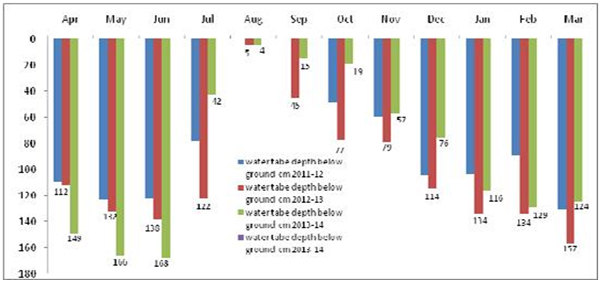 |
|
Effect on Water Table due to Nallah digging & tree planting at Nimsariya village
|
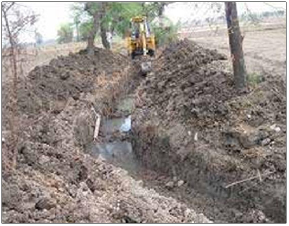 |
 |
|
Digging of Nallah at Nimsariya village |
With this entry point activity, the disposal of runoff water and stagnated surface
water was fast as compared to previous years. The quick removal of run- off water
attracted the farmers. The soil moisture condition at the harvesting of paddy and
at sowing of wheat was favorable. Some farmers could sow the wheat crop for the
first time. Due to continuous meetings with farmers and the entry point activity
of digging JhinnaNallah, a strong rapport was established between scientists of
bio-drainage project and farmers of study area.
Farming System Research (FSR) in Water Logged Area
The yield performance of improved paddy variety of kranti was superior than the
local paddy varieties of 1121, Dehradun and Sonam. In severe water logged fields.
Kranti with tree bunded fields gave 32%, 71% and 4% more paddy yield as compared
to varieties 1121, Dehradun and Sonam respectively in non treebunded fields. Similarly,
variety kranti gave 78%, 93% and 27% respectively higher yield as compared to 1121,
Deharadun and Sonam with tree less bunds. The overall performance of kranti in water
logged fields (0-2m) with tree bunds was also superior as compare to tree less bunds.
Kranti gave 58%, 84% and 18% respectively higher yields as compare to 1121, Dehradun
and Sonam. Kranti in tree bunded fields produced 48% higher yield as compare to
local varieties in tree less bunded fields. Similarly, improved variety of wheat
MP 1203 was supplied to those cultivators who were planted tree species on their
bunds to arrest water logging situation. The wheat yields in bunds plantation with
improved variety were superior as compared to local wheat without bund plantations.
 |
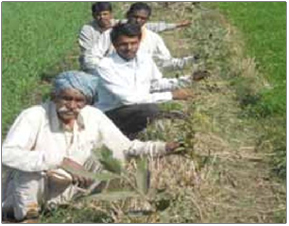 |
|
Submergence of the study area during rainy season Terminaliaarjuna plantation
|